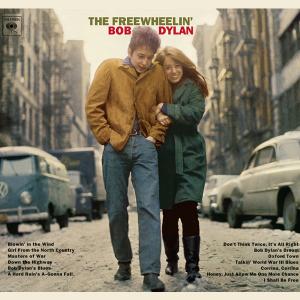
The Freewheelin' Bob Dylan (1963)

1. Blowin' in the Wind
2. Girl From the North Country
3. Masters of War
4. Down the Highway
5. Bob Dylan's Blues
6. A Hard Rain's A-Gonna Fall
7. Don't Think Twice, It's All Right
8. Bob Dylan's Dream
9. Oxford Town
10.Corrina Corrina
11.Talking World War III Blues
12.Honey, Just Allow Me One More Chance
13.I Shall Be Free
It is rare for a second album to redefine not only the artist’s trajectory but also the parameters of popular songwriting itself. Yet The Freewheelin’ Bob Dylan, released in 1963, accomplished precisely that. Had it not arrived in the shadow of a concurrent cultural earthquake—namely the rise of The Beatles—it might today be recognized less as an influential folk record and more as a seismic shift in 20th-century lyrical expression. Still, even within that crowded pantheon, Freewheelin’ endures as a singular achievement: the moment Bob Dylan ceased to be a curious new arrival and emerged instead as the defining voice of his generation.
Where his 1962 debut offered a modest collection of folk standards and tentative originals, The Freewheelin’ Bob Dylan was something entirely different. It was original in both content and spirit, with Dylan now writing the majority of the material. From the opening bars of Blowin’ in the Wind, it was evident that this was no longer a young man echoing his heroes—he had become one. The song, a masterclass in lyrical ambiguity and spiritual urgency, quickly became a civil rights anthem and remains among the most covered compositions in the American songbook.
But it was A Hard Rain’s A-Gonna Fall that truly announced Dylan’s poetic command. Sprawling, apocalyptic, and filled with surreal imagery, the song defied the folk form while simultaneously elevating it. That Dylan later admitted much of his writing came effortlessly does not diminish the achievement. If anything, it underlines the almost prophetic clarity with which he articulated themes of war, injustice, and human frailty.
Musically, the album remained sparse: acoustic guitar, harmonica, and that unmistakable voice. Even in his early twenties, Dylan's vocal delivery was divisive. Some dismissed it as nasal and untrained, but it was precisely this unvarnished tone—direct, conversational, unpretentious—that gave his songs their moral authority. Unlike the polished crooners of the time, Dylan sounded like someone who had lived what he sang, or at least believed it deeply enough to matter.
The album wasn’t all polemic. Humorous touches—particularly on tracks like Talkin’ World War III Blues and the self-referencing Bob Dylan’s Blues—reminded listeners that this was still the folk tradition, with all its wit and storytelling charm intact. That Dylan could pivot so easily between social commentary and wry narrative was yet another indicator of his emerging complexity as an artist.
The Freewheelin’ Bob Dylan is, by most critical standards, one of the greatest albums of the 1960s, and arguably the most influential record in Dylan’s entire oeuvre. It captured a particular moment in American consciousness just before everything changed, and yet, it somehow transcends its era. The names and events referenced may have faded into history, but the conviction, intelligence, and quiet defiance of these songs remain undiminished.
Go back to the main page
Go To Next Review